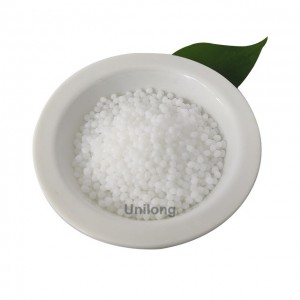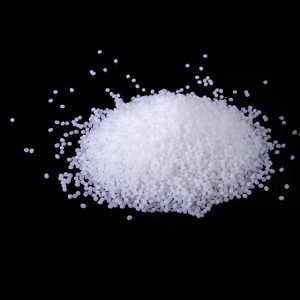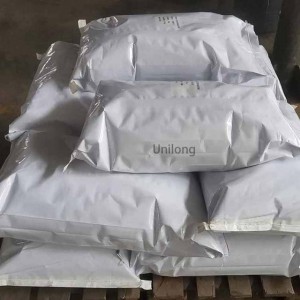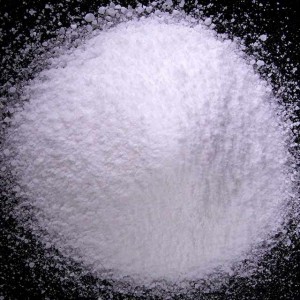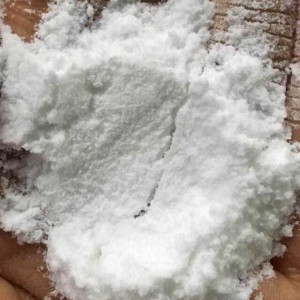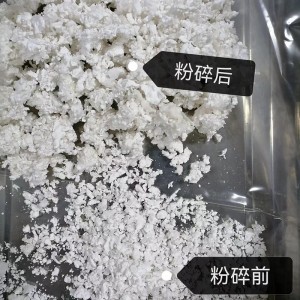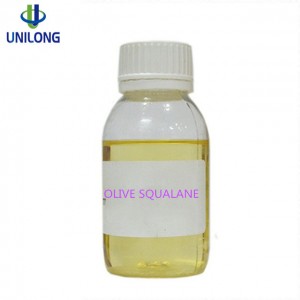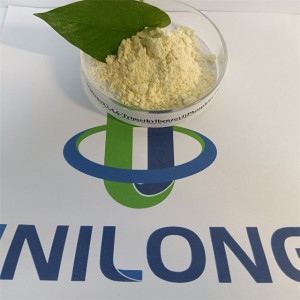Polycaprolactone CAS 24980-41-4
Polycaprolactone (PCL) is a semi crystalline polymer, which is a chemically synthesized biochemicalbook degradable polymer. Its structural repeating unit is blended with five nonpolar methylene CH2 starch and other substances to produce a complete biodegradable material.
| Item | Specifications | Results |
| Characters | White powder particle/granule | White powder particle/granule |
| Inherent Viscosity | dl/g(Viscosimeter) | 0.82 dl/g |
| MN | 60000-80000 | Conforms |
| Melt Index | 22-26g /10 min150℃ | 23 |
| Melting Point | 58-60℃ | 60 |
| Specific Gravity | 1.08-1.12 g/ml(25℃) | 1.12 |
| Water Content | ≤1.0% | 0. 5% |
| Polydispersity index | ≤1.8 | 1.8 |
| Conclusion | The results conforms with enterprise standards | |
I. 3D Printing Field: Ideal consumables for high precision and customization
In the field of 3D printing (additive manufacturing), polycaprolactone PCL has become one of the mainstream degradable 3D printing materials due to its low melting point (about 60℃), good melt fluidity and interlayer bonding strength. PCL polymer is particularly suitable for technical paths such as fused Deposition modeling (FDM) and stereolithography, and is widely used in the following scenarios:
Personalized model and prototype making: Polycaprolactone PCL has a moderate heat distortion temperature, which makes it less likely to warp or crack during the printing process. It can precisely replicate complex structures (such as mechanical part prototypes and architectural miniature models), and the printed parts have a high surface smoothness, requiring no excessive post-processing. Meanwhile, the degradable property of Polycaprolactone PCL makes it suitable for "single-use" prototype scenarios (such as automotive parts test models), reducing material waste.
Biomedical 3D printing As a material with excellent biocompatibility: polycaprolactone PCL stands out in the printing of tissue engineering scaffolds. By adjusting the molecular weight of the material or combining it with bioactive substances such as hydroxyapatite (HA) and collagen, porous scaffolds that match the growth requirements of tissues such as bones and cartilage can be prepared. The scaffold can be gradually degraded in the body, providing support space for new tissues. Currently, PCL polymer has been used in medical printing research such as bone repair and skin regeneration.
In the fields of education and creativity: The low melting point of polycaprolactone PCL enables printing without the need for high-temperature equipment, ensuring high safety. It is suitable as an introductory material for 3D printing in educational scenarios. polycaprolactone PCL is used to create teaching models (such as human organ models and chemical molecular structure models). Meanwhile, its characteristic of slowly deforming at room temperature also supports the creative design field in making art installations or toy accessories with adjustable shapes.
Ii. Disposable Food Packaging Field: Dual guarantees of green degradation and safety protection
In the field of disposable food packaging, polycaprolactone PCL has become an important alternative to traditional non-biodegradable plastics (such as polyethylene and polypropylene) due to its complete biodegradability, good barrier properties and food contact safety, helping to solve the problem of "white pollution". Its main application forms include
Degradable food packaging film/bag: PCL can be blended and modified with natural polymer materials such as starch and polylactic acid (PLA) to enhance the flexibility and water resistance of the materials, and be made into films or preservation bags for packaging fresh food (such as fruits and vegetables) and cooked food - this type of packaging can be used in natural environments (such as soil and composting conditions) polycaprolactone PCL can gradually degrade into carbon dioxide and water within 6 to 12 months without leaving any residual pollution. Meanwhile, PCL polymer has excellent chemical stability and does not react with oils or acidic substances in food, meeting the safety standards for food contact materials (such as FDA certification).
Disposable food containers and tableware: Through injection molding or hot pressing processes, polycaprolactone PCL can be compounded with plant fibers (such as straw fibers, bamboo fibers) to produce disposable lunch boxes, plates, knives, forks and other products. This type of product not only has excellent load-bearing capacity and heat resistance (able to withstand hot food temperatures of 60-80℃), but PCL polymer can also be degraded through composting after use, avoiding the long-term environmental pollution caused by traditional plastic tableware. It is especially suitable for high-frequency disposable packaging scenarios such as takeout and fast food.
Iii. Medical Sheet Materials Field: Core materials for biocompatibility and functional adaptation
In the field of medical plates, polycaprolactone (PCL) has become a key raw material for manufacturing medical repair plates and protective plates due to its excellent biosafety, controllable degradation rate and mechanical properties. Its main application directions include:
Medical repair boards: In fields such as orthopedics and dentistry, polycaprolactone PCL can enhance its mechanical strength through modification (such as compounding hydroxyapatite and tricalcium phosphate), and be made into bone defect repair boards and alveolar bone reconstruction boards. After being implanted into the human body, this type of board can not only provide immediate support for damaged bones but also gradually degrade along with the regeneration of the body's own bones, avoiding the risk of secondary surgery for removal. Meanwhile, the biocompatibility of polycaprolactone PCL can reduce immune rejection after implantation, promote cell adhesion and tissue integration, and has been clinically applied in minimally invasive bone repair surgeries.
Medical protective and isolation boards: PCL has excellent film-forming and barrier properties and can be made into medical isolation boards (such as wall protection boards for operating rooms and surface isolation layers for medical devices). This type of board not only effectively prevents the penetration of bacteria and viruses, but also has certain flexibility and disinfection resistance. It can withstand repeated wiping with alcohol and chlorine-containing disinfectants, and is degradable after disposal, reducing the pressure of medical waste treatment. In addition, polycaprolactone PCL can also be combined with antibacterial agents (such as silver ions) to further enhance the long-lasting antibacterial performance of protective boards, making it suitable for scenarios with extremely high requirements for environmental cleanliness, such as infectious disease departments and icus.
Iv. Other Fields: Functional extension fields
In addition to the above-mentioned core areas, polycaprolactone PCL also plays a role in multiple scenarios:
Coatings and adhesives: polycaprolactone PCL, as a core film-forming component of water-based or solvent-based coatings, can enhance the flexibility, impact resistance and weather resistance of the coating - for instance, when used in the outer wall coating of metal pipes, it can reduce the cracking of the coating caused by the contraction of the pipes due to temperature changes. polycaprolactone PCL is used as a surface coating for plastic toys, making the coating more wear-resistant and less prone to peeling. Moreover, as PCL itself is non-toxic, it can meet the safety standards for children's toys. In addition, adding PCL polymer to wood coatings can also improve the color rendering of wood grain and enhance the appearance texture.
Agricultural materials: polycaprolactone PCL is made into degradable agricultural films, which are used for crop seedling raising, water and fertilizer retention. After degradation, they can be transformed into soil organic matter, avoiding soil pollution caused by residual films. Or it can be made into a slow-release fertilizer carrier to control the nutrient release rate, and PCL polymer can improve the fertilizer utilization rate. The "controllable degradation" feature of PCL perfectly meets the agricultural demands for "functionality" and "environmental friendliness", and is mainly used to solve the pollution problems of traditional agricultural materials
Composite material modifier: polycaprolactone PCL is blended with polyolefins, polyester and other materials to improve their flexibility and impact strength, making it suitable for scenarios with high requirements for material performance, such as automotive interior parts and home appliance shells.
Fiber/Fabric modification: polycaprolactone PCL is used for coating or grafting modification of polyester and cotton fibers to enhance their elasticity, wear resistance and anti-wrinkle properties. For instance, adding PCL coating to sportswear fabrics can make the fabrics more stretchable and less prone to deformation. Grafting PCL into medical gauze fibers can enhance the moisture absorption and retention of the gauze, improve its adhesion to the skin, and reduce the discomfort caused by wound friction.

1. Controlled release drug carrier, cell and tissue culture media frame
2. Fully biodegradable plastic surgical suture
3. High strength film filament molding
4. Low temperature impact property modifier and plasticizer of plastics
5. Medical modeling materials, industrial, artistic modeling materials, toys, organic colorants, hot copy ink adhesives, hot melt adhesives.
A biodegradable polymer, non-toxic, biodegradable in soil, excellent mixing, mechanical compatibility with many polymers and good viscosity to many matrices. Extrusion aids, mold lubricants, release agents, pigment and filler dispersing aids, and polyester segments in polyurethane and block polyester.
25kgs/drum, 9tons/20’container
25kgs/bag, 20tons/20’container






